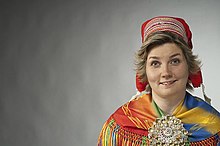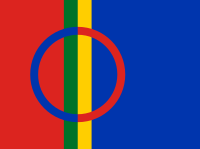Sameting (Norway)
| Parliament logo | Parliament building |
|---|---|
|
|

|
| Basic data | |
| Seat: | Karasjok |
| Legislative period : | four years |
| First session: | October 9, 1989 |
| MPs: | 39 |
| Current legislative period | |
| Next choice: | September 2021 |
| Chair: | Aili Keskitalo |

|
|
| Distribution of seats: |
Government (23)
|
| Website | |
| sametinget.no | |
The Sami Parliament in Norway ( Norwegian Sametinget ; North Sami Sámediggi ; Lule Sámedigge ; South Sami Saemiedigkie ) is the parliament of the seeds in Norway . The seat of parliament is in the northern Norwegian municipality of Karasjok in the province of Troms og Finnmark . In Sweden and Finland , there is a respective Sami Parliament .
history
Oppression of the seeds
Since the beginning of the 19th century, the Sami population was oppressed, based on a policy of Norwegianization. This came to an end after the end of the Second World War , but Sámi concerns continued to find little attention in state politics. In addition, the Sami as a minority could not prevail in the majority-based parliaments. In 1964, the Norwegian Sami Council ( Norwegian : Norsk Sameråd ) was established, which had an advisory role to the Norwegian authorities on Sami matters. In the 1970s, the so-called Alta conflict broke out after the decision to build a hydropower plant in Alta . Among other things, there were hunger strikes in 1979 and 1981 in front of the Norwegian parliament in Storting .
Samelov
Through these protests and the resulting international pressure, the Norwegian authorities became more aware of the rights of the Sami. The Sami were subsequently recognized not only as a minority , but also as an indigenous population in Norway. On October 10, 1980, the Samerettsutvalg (Committee on Sami Rights) and the Samekulturutvalg (Committee on Sami Culture) were created. The Legal Committee presented its first results in 1984, which formed the basis for the Lov om Sameting og andre samiske rettsforhold (Law on Sameting and Other Sámi Legal Relationships), or Samelov for short, passed in 1987 .
In September 1989 the first elections for the Sameting were held. On 9 October 1989, the Parliament in Karasjok was by King Olav V opened. The parliament replaced the Norwegian Seed Council.
Parliament building
The current Parliament building was opened by King Harald V on November 2 2000th In addition to the plenary hall , Parliament's administration is also located there. Construction work began in August 1998. In November 2015, an extension with new offices was completed. There are branches of the Parliament in other Norwegian towns, such as Kautokeino , Nesseby , Drag , Snåsa , Tromsø , Skånland and Kåfjord .
organization
elections
Elections for the meeting take place every four years, parallel to the elections for the storting . 39 MPs are elected. Norway will be divided into seven constituencies for these elections: Nuortaguovlu, Ávjovárri, Davveguovlu, Gáissaguovlu, Viesttarmearra, Åarjiel-Saepmie (South Sami constituency) and Lulli-Norga (South Norwegian constituency). By 2009 there were 13 constituencies. Today's constituencies are independent of the Norwegian administrative division and are based on the traditional Sami borders. Each constituency is awarded two mandates, the other 25 mandates are distributed based on the number of eligible voters in a constituency.
Eligible voters
All persons who have registered in the Sametingets valgmanntall and are also entitled to vote in the Norwegian local elections are entitled to vote. The register is intended to serve as a list for people who are allowed to vote in the Saturday elections and stand as candidates. Only employees of the administration of the meeting cannot be elected to the meeting. In order to be able to enroll in the register, one must make a declaration that one considers oneself to be Sami. You also have to assure that you either speak Sami yourself or that you are the child, grandchildren or great-grandchildren of a Sami-speaking person. The fact that you are the child of someone who is already on the register is enough to be accepted.
In 1989 there were 5,500 people on the register. In the 2017 election, 16,958 people were eligible to vote, in 2019 there were already 18,103 people in the register. In the 2017 election, 70.3% of those eligible to vote voted.
Parties
Many all-Norwegian and Sami parties are running in the elections. To be allowed to stand as a party or group, 200 signatures from people who are allowed to vote in the Saturday elections are required. The most successful over time were the Arbeiderpartiet (Ap) and the Norske Samers Riksforbund (NSR).
Plenary sessions
Usually four plenary sessions are held each year. These are also open to the public. The meetings are chaired by the plenary president, who mostly comes from the ranks of the opposition parties. From a formal point of view, the President of the Plenary is the highest member of Parliament. In addition to chairing the meetings, the plenary presidium is also responsible for appointing representatives from the Sameting to conferences at which Parliament is to be represented. The Sameting President is also elected by the MPs. The latter in turn appoints four other members of the parliament, called Sametingsråd . This board acts as the government of the Sameting and is responsible for its day-to-day work. For example, he submits budget proposals to Parliament. The Sametingsråd can also decide to let parliament vote on other issues . The members of the Sametingsråd resign from parliament and are represented there by their vara representatives.
The meetings of the individual committees are held before the plenary meeting. Every MP is a member of such a parliamentary committee. There are currently committees for planning and finance, for upbringing and education, and for business and culture. There is also a control and an election committee.
As the working language in the Sameting, the individual MEPs can freely choose between a Sami language and Norwegian .
Presidents of Parliament

- 1989–1997: Ole Henrik Magga (Norske Samers Riksforbund, NSR)
- 1997-2005: Sven Roald-Nystø (NSR)
- 2005–2007: Aili Keskitalo (NSR)
- 2007–2013: Egil Olli ( Arbeiderpartiet , Ap)
- 2013–2016: Aili Keskitalo (NSR)
- 2016–2017: Vibeke Larsen (Ap, independent)
- since 2017: Aili Keskitalo (NSR)
Jurisdiction
The Sameting has no right to veto decisions by the Norwegian Parliament in Storting , even on issues that affect Sami interests, such as Sami culture or the traditional Sami areas in northern Norway. Instead, the Sameting is given the right to be heard in such cases. In the case of laws that affect the entire Norwegian population, however, the Sameting does not have to be included. The basis for the adopted in June 2005 law Konsultasjonsavtalen (German: Consultation Agreement).
The Sameting is responsible for regulating the use of the Sami flag throughout Norway. Other responsibilities include areas of work that the state hands over to the Sameting. The exact areas of responsibility change more frequently. Once a year the parliament has to submit an annual report to the Norwegian king .
Saturday elections 2017
Since the 2017 Saturday election, the mandates have been distributed as follows:
| Political party | Mandates |
|---|---|
| Norske Samers Riksforbund | 18th |
| Workers' part | 9 |
| Nordkalottfolket | 3 |
| Senterpartiet | 2 |
| Árja | 1 |
| Fremskrittspartiet | 1 |
| Høyre | 1 |
| Kautokeino Fastboendes list | 1 |
| Flyttesamelista | 1 |
| Samefolkets parti | 1 |
| Åarjel-Saemiej Gïelh | 1 |
A coalition of Norske Samers Riksforbund (NSR), Flyttesamelista, Senterpartiet (Sp) and Åarjel-Saemiej Gïelh has existed since 2017 .
Sametingsråd
The Sametingsråd, i.e. the government of the Sameting, is currently composed as follows:
- Aili Keskitalo ( NSR ), President
- Henrik Olsen (NSR)
- Silje Karine Muotka (NSR)
- Mikkel Eskil Mikkelsen (NSR)
- Hans Ole Eira ( Senterpartiet )
Web links
- sametinget.no official website (Norwegian, Sami)
- Sameting in the store norske leksikon (Norwegian)
Individual evidence
- ↑ Bakgrunn. Sameting, accessed January 31, 2020 (Norwegian).
- ↑ Asbjørn Nesheim: Norsk Sameråd . In: Store norske leksikon . March 2, 2018 ( snl.no [accessed January 31, 2020]).
- ↑ Historikk. Sameting, January 13, 2017, accessed January 31, 2020 (Norwegian).
- ↑ Sametingsbygningen. Accessed January 31, 2020 .
- ↑ Architecture. Sameting, accessed January 31, 2020 (Norwegian).
- ↑ a b c d e f Mikkel Berg-Nordlie: Sametinget . In: Store norske leksikon . October 9, 2019 ( snl.no [accessed January 31, 2020]).
- ↑ Om Sametinget. Sameting, accessed January 31, 2020 (Norwegian).
- ↑ Lov om Sametinget and other samiske rettsforhold (sameloven) - Chapter 2. Sametinget. § 2-4. Retrieved February 6, 2020 .
- ↑ Lov om Sametinget and other samiske rettsforhold (sameloven) - Chapter 2. Sametinget. - § 2-7. Retrieved February 6, 2020 .
- ↑ Lov om Sametinget and other samiske rettsforhold (sameloven) - Chapter 2. Sametinget. - § 2-7. Retrieved February 6, 2020 .
- ^ About the Sámi Parliament. Sameting, accessed on January 31, 2020 .
- ↑ a b Sametingsrådet. Sameting, accessed February 6, 2020 (Norwegian).
- ↑ Sametingets order of labor. Forretningsorden and green regulator. (doc) Sameting, June 1, 2017, accessed on February 6, 2020 (Norwegian): "Presidents og de fire representantene som blir utnevnt til medlemmer i sametingsrådet, trer ut av plenum og vararepresentantene tar sete som representanter."
- ↑ Lov om Sametinget and other samiske rettsforhold (sameloven) - Chapter 2. Sametinget. - Lovdata. Retrieved February 6, 2020 .
- ↑ Konsultasjonsavtalen. In: Sameting. January 13, 2017, accessed January 31, 2020 (Norwegian).
- ↑ Forskrift om bruk av det samiske flag - - Lovdata. Retrieved February 6, 2020 (Norwegian).
- ↑ Lov om Sametinget and other samiske rettsforhold (sameloven) - Chapter 1. Allmenne bestemmelser. - Lovdata. Retrieved February 6, 2020 .


